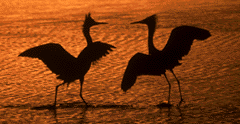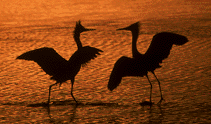|
BIRDS AS ART BULLETIN #20
FEEDBACK AND QUESTIONS ON STACKED DOUBLER IMAGE
IMPORTANT NOTES:
FIRST PRIBILOFS TRIP SOLD OUT/ONLY ONE SLOT LEFT FOR SECOND
TRIP. SEE WEB SITE FOR DETAILS
We received tons of feedback and many questions on the Great
Egret image made with stacked 2X tele-converters on the Canon 600mm f/4L Image
Stabilizer lens.
Many folks commented that the image appeared very sharp on
their monitors, a few said that it looked soft. And a very few were unable
to open the image despite my re-e-mailing it. (It was a j-peg created on
Adobe Photo Shop 5.5.) Special thaks to Jeff Page who sent detailed
technical advice and great suggestions for sending future images with
Bulletins.
Peter LaTourette was the first of many to point out that
stacked 2Xs yield an effective aperture of f/16, not f/11 (four stops darker
than the wide open aperture of f/4) as I stated incorrectly in Bulletin
#19. (Hell, I was really tired.....) In any case, I I am sorry
for the screw-up.
All are assured that the image is beyond-comprehension sharp
when viewed on a lightbox with a Schneider 4X loupe. When I first saw the
series of images, I said, "When did I get that close to a gorgeous Great
Egret?" Then I realized that they were the images of a bird on top of the
rookery, more than 100 feet away. And realized that they were made with the
stacked 2X TXs..... I was stunned by how sharp the images were.
Some folks asked if I used a tripod. The answer of
course was YES. (Those folks have never met a 600mm f/4 lens--the IS
version weighs more than 12 pounds wiithout the camera body. In
fact, I used the Gitzo Carbon Fiber 1548 and a Wimberly Head.
The Wimberely Head was totally locked down. The bird was
scratching but did hold it's head still for quite
a while so that I had time to focus and lock the tripod head.
Remember, I was shooting at 1/100 and 1/125 sec. at 2400mm!
Many folks asked about the 12mm extension tube. With the
Canon system, an extension tube is needed so that the TCs are able to
mate. With Nikon, you need to file off a pin on the front of the rear
tele-converter. I did let them know that they should own a copy of "The
Art of Bird Photography," as the INFO on stacking TCs is covered in the
text. Some replied that they already owned it and really were serious
about improving their photography. I told them, YOU'VE GOT TO
READ THE BOOK! (Visit the web site to order a signed
copy if you do not have one.)
Here are some of the recent e-mails:
My reply to Mike Butcher:
Hi Mike,
I've been an avid reader of your
e-mails (and books) and have come to expect
tremendous shots. The
attachment is no exception, and certainly looks sharp
on my screen.
Thanks!
Could this same image could have
been made with a non-IS lens and
stacked TC's?
Absolutely NOT. NOT without IS
technology.
In this situation, does the IS feature make a big
difference or could your older 600mm/f4 lens have done as well (assuming you
stayed away from the vibration-prone 1/4 - 1/30 shutter
speeds)??
No chance in hell with stacked
doublers.
From your description, it sounds like the 12mm tube
was mounted between the TC's. Does the extra extension (doubled by the
in-board TC) have any effect on maximum working distance - could you have used
this rig at 200 feet?
I don't know what's up with stacked 2Xs at
infinity, I'll have to check but feel that it will focus to
infinity. With the 2X and the 1.4X stacked, you can focus on the sun
as their is extra focus past infinity built into the
lens......
With the added distance between the camera and
mounting point (and the additional connections points), do you use any type
of bracket (attached to both camera body and lens foot, to keep all this
balanced and rigid?
No. I simply slide my Really Right
Stuff plate forward in the mount to balance the whole rig. That is why I
like L O N G plates. AND, I MAKE SURE
THAT THE IMAGE STABILIZER IS ON AND SET TO MODE ONE!
Mike, thanks for your thoughtful questions. Some of
them that I get make me want to pull my hair out.
Best, AM
My Reply to Kim Likakis:
Dear Kim
Re:
Hi Artie - Please take
me off your quasi-Canon mailing list. Thanks.>
No
problem. Sticking your head in the sand is a great way to avoid
learning
about new technology. Best and great picture making,
AM
My reply to Juli Wilcox:
Hi Juli,
Re:
What's the main thing to remember as far as technique with 2
2x's?
Use perfect sharpness techniques as described in
"The Art of Bird Photogrpahy" plus a few new
ones that I've developed for the Wimberley
Head.
Did you take closer to a few dozen or a few hundred shots to get this
one?
I took about 8 head shots, all sharp but head
angle to me and light not to good. Took about 5 scratching shots
like the one shown (it takes more than a few seconds to frame the shot and
tighten the two Wimberley knobs). All were sharp.
Did you get other great shots with the stacked 2x's?
Took a long series of another Great Egret with a big
stick. Got one very sharp one but many were soft--due to improper
focus, I believe. Was using Provia pushed one stop then and shooting at
1/250 sec...... Go figure.
I have been using the 1.4 and 2x with a 12mm and don't think much of the
results so my question on technique has nothing to do with idle
admiration.
IS is no subsitute for sloppy technique (nothing
personal). Experienced photographers emplying perfect sharpness
technique will be able to push the envelope that much farther when using
IS. They will be able to make sharp images at slower shutter speeds and
at ridiculous focal lenghts (like 2400mm). I
guess, then, that your next question will be "What are maximum
sharpness techniques?" Best, Artie
The next Bulletin will detail maximum sharpness techniques
that I have devleoped for the Wimberly Head. (By the way, we will have
Wimberley heads to ship in a few days: regular head: $565 with Kirk
clamp plus $15 shipping. Sidekick: 250 with Kirk clamp plus $10.00
shipping.)
My reply to Dave McShaffrey (and others):
Hi Dave,
Re:
I've had a Nikon LS 2000 for a few years, and I always find it
necessary to sharpen a bit to get back to the sharpness of the original.
Perhaps this Laser Fast software makes the difference
As far as sharpness, I simply do not
know.....
What is Laser Fast? Is it an enhancement to the
Nikon Scan or is it a third-party effort?
It is superior (so I am told) third party software
for the LS 2000. It costs about $600; I purchased it on the advice of
several experienced friends. Best, AM
Best and great picture making to
all.
AM
P.S. The Baton Rouge programs and field shoots were a huge
success. Lake Martin was mildy disappointing as the birds, thousands of
them, were far away, but one GREAT spoonbill nest and lots of wonderful
macro
opportunities made for lots of teaching and learning. Thanks to
all who attended.
Note: Arthur Morris has been a Canon contract
photographer since 1994 and continues in that role today. If you
received this bulletin in error, or would like your name removed from the
subscriber list, simply respond by e-mail and request same.
|


